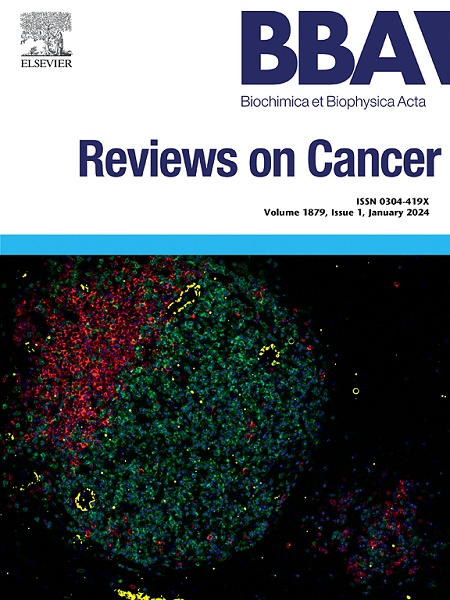Mitochondrial DNA-activated cGAS-STING pathway in cancer: Mechanisms and therapeutic implications
IF 9.7
1区 医学
Q1 BIOCHEMISTRY & MOLECULAR BIOLOGY
Biochimica et biophysica acta. Reviews on cancer
Pub Date : 2025-02-01
DOI:10.1016/j.bbcan.2024.189249
引用次数: 0
Abstract
Mitochondrial DNA (mtDNA), a circular double-stranded DNA located within mitochondria, plays a pivotal role in mitochondrial-induced innate immunity, particularly via the cyclic GMP-AMP synthase (cGAS)-STING pathway, which recognizes double-stranded DNA and is crucial for pathogen resistance. Recent studies elucidate the interplay among mtDNA, the cGAS-STING pathway, and neutrophil extracellular traps (NETs) in the context of cancer. mtDNA uptake by recipient cells activates the cGAS-STING pathway, while mtDNA leakage reciprocally regulates NET release, amplifying inflammation and promoting NETosis, a mechanism of tumor cell death. Autophagy modulates these processes by clearing damaged mitochondria and degrading cGAS, thus preventing mtDNA recognition. Tumor microenvironmental factors, such as metabolic reprogramming and lipid accumulation, induce mitochondrial stress, ROS production, and further mtDNA leakage. This review explores strategies in cancer drug development that leverage mtDNA leakage to activate the cGAS-STING pathway, potentially converting ‘cold tumors’ into ‘hot tumors,’ while discussing advancements in targeted therapies and proposing new research methodologies.
线粒体dna激活的cGAS-STING通路在癌症中的作用机制和治疗意义。
线粒体DNA (mtDNA)是一种位于线粒体内的环状双链DNA,在线粒体诱导的先天免疫中起着关键作用,特别是通过环状GMP-AMP合成酶(cGAS)-STING途径,该途径识别双链DNA,对病原体抗性至关重要。最近的研究阐明了mtDNA、cGAS-STING通路和中性粒细胞胞外陷阱(NETs)在癌症中的相互作用。受体细胞对mtDNA的摄取激活了cGAS-STING通路,而mtDNA的泄漏则相互调节NET释放,放大炎症并促进NETosis,这是肿瘤细胞死亡的一种机制。自噬通过清除受损的线粒体和降解cGAS来调节这些过程,从而阻止mtDNA识别。肿瘤微环境因素,如代谢重编程和脂质积累,诱导线粒体应激、ROS产生和进一步的mtDNA泄漏。这篇综述探讨了利用mtDNA泄漏激活cGAS-STING途径的癌症药物开发策略,潜在地将“冷肿瘤”转化为“热肿瘤”,同时讨论了靶向治疗的进展并提出了新的研究方法。
本文章由计算机程序翻译,如有差异,请以英文原文为准。
求助全文
约1分钟内获得全文
求助全文
来源期刊

Biochimica et biophysica acta. Reviews on cancer
医学-生化与分子生物学
CiteScore
17.20
自引率
0.00%
发文量
138
审稿时长
33 days
期刊介绍:
Biochimica et Biophysica Acta (BBA) - Reviews on Cancer encompasses the entirety of cancer biology and biochemistry, emphasizing oncogenes and tumor suppressor genes, growth-related cell cycle control signaling, carcinogenesis mechanisms, cell transformation, immunologic control mechanisms, genetics of human (mammalian) cancer, control of cell proliferation, genetic and molecular control of organismic development, rational anti-tumor drug design. It publishes mini-reviews and full reviews.
 求助内容:
求助内容: 应助结果提醒方式:
应助结果提醒方式:


